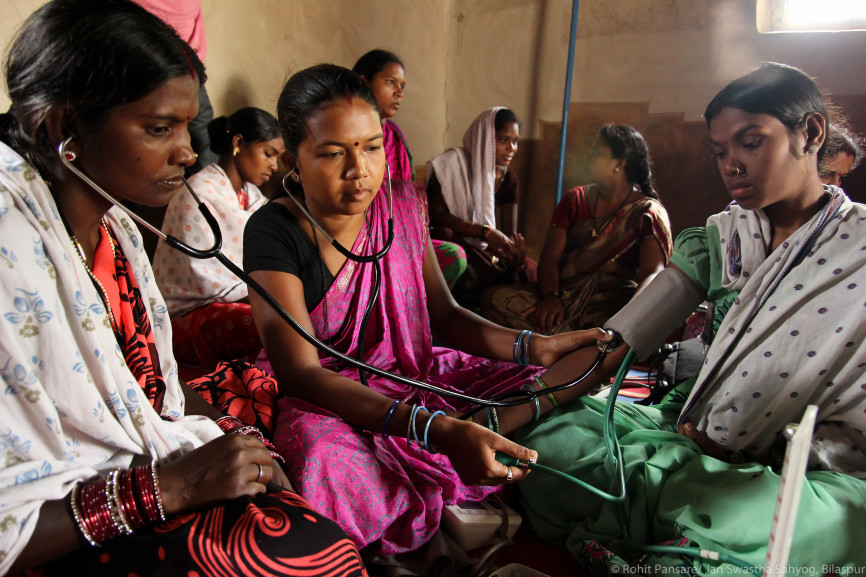The last two decades have witnessed the emergence of several healthcare innovations by social entrepreneurs in India. However, one of the biggest challenges they face is moving from pilot to the scale-up stage and ensuring that the first user and the ten thousandth user, both have the same quality of experience.
To identify opportunities and challenges of scale for healthcare social enterprises, I was involved in a study1 of the sector, interacting with founders of social enterprises, government representatives, healthcare professionals, and health workers.
Drawing on that study, this article looks at what social enterprises can do to make the process of scaling up easier.
Related article: A replicable model for urban healthcare
While the proposed design of a solution may seem innovative, if a social enterprise wants to address the public healthcare delivery system, ensuring relevance and alignment to the national and/or state priorities at the ideation and concept stage is helpful.
For instance, India’s maternal mortality ratio (MMR) is 130 per one lakh live births, while the SDG target is seventy by the year 2030. The MMR in EAG states2 and Assam is 188. To tackle this problem, an organisation designed a programme that provided timely and regular assistance to women over a standard mobile phone during their pregnancy. Another organisation focused on helping staff nurses detect high-risk cases and preparing digital partographs in the labour room.
These solutions aligned well with National Health Mission’s effort to reduce MMR, including the Labour Room Quality Improvement Initiative (LAQSHYA), as well as WHO’s guidance to plot partographs in the labour room. As a result, they found it easier to get government procurement and scale their operations.
To solve a public health problem, social enterprises often turn to technology. But a tech-driven approach might not be the most optimal approach from a public health perspective, if conditions such as low-resource settings and social issues are not factored in.

As innovations may be implemented in villages, where the user of the product may be a patient who is not equipped to question an intervention, it is critical to ensure that ‘do no harm’ principles and ethics are followed| Photo courtesy: Rohit Pansare, Jan Swasthya Sahyog
For instance, an intervention to provide doorstep diagnostics to pregnant women to identify high-risk cases, might address the access issue in a rural area, but it needs to understand the social setting as well. These could include gaining the trust of the woman’s family, availability of space for examination of the pregnant woman, the comfort of health workers in using technology, and so on.
The value of the product for the public health sector needs to be evaluated from various aspects: necessity, efficacy, efficiency, and cost-effectiveness. It also needs to be evaluated against the side-effects or harm it potentially causes, and whether it is replicable in different environments, such as private hospitals, primary health centres, and so on.
Users gain confidence in an innovative approach if its efficacy and cost-effectiveness are tested against those of alternative approaches including:
- Approaches taken by other organisations in solving the same problem
- Approaches that the social enterprise was contemplating but rejected at the design stage
- An older, more established approach
However, it is not enough to simply conduct these analyses and document it internally. It is important to have it published in peer-reviewed journals. Doctors do not get excited about innovation just because it is technology based. They are keen to know whether it is sufficiently tested and what their peers have to say about it. Hence, if a social enterprise can collaborate with a reputed health institute or research centre at an early stage and publish evidence, they can expect to be seen more favourably when it is time to scale.
As innovations may be implemented in rural locations, wherein the user of the product may be a patient who is not equipped to resist or question an intervention, it is critical to ensure that ‘do no harm’ principles and ethics in trials are diligently followed. The public health team should be involved, both to define ethical ways of testing and to factor in social aspects.
As innovations may be implemented in rural locations, it is critical to ensure that ‘do no harm’ principles and ethics in trials are diligently followed.
While testing a product, or in the ‘proof of concept’ stage, the design and development team also needs to be hands-on, so that they get first-hand information about the user experience. Therefore, these tests should be conducted in areas that can be easily accessed by the team. This will allow them to observe and address complications in using the product, or include specific instructions for users when the product is scaled to areas which are not easily accessible.
Related article: Understanding community health workers
Spending disproportionate time on refining a product during the pilot will ensure a smoother process during scale.
Social enterprises usually approach government officials at later stages, such as the pilot stage or when they seek government procurement. But they must engage with the government much earlier, ideally during the design process. There could be similar solutions already available in another part of the country and social enterprises might not know about them.
A public health official will have greater visibility and exposure to such products, and conferring with them at an early stage could potentially avoid duplication of work, and provide insights on the product and demand for it, from the government’s perspective.
In the early stages, when social enterprises are developing prototypes and seeking user feedback, they think of it as ‘feature testing’ rather than a formal field trial. Many of them skip mandatory government processes like getting approvals from local ethics committees and registering with the Clinical Trials Registry of India (CTRI). There is also a wrong perception that these approvals are only meant for new drugs or invasive medical devices.
The CTRI requires all trials to be registered before the first participant is enrolled. Their guidelines state that ‘any researcher who plans to conduct a trial involving human participants, of any intervention such as drugs, surgical procedures, preventive measures, lifestyle modifications, devices, educational or behavioural treatment, rehabilitation strategies is expected to register the trial in the CTRI before enrolment of the first participant’. Many social enterprises are unaware of this, which could be a challenge when it is time to scale.
The holy grail for most health innovations is to partner with the government and secure adoption from the government. Social enterprises often remark about the lack of avenues to partner with the government, and that the process is slow and complicated. While the government needs to do more on this front, social enterprises can also better acquaint themselves with the processes.
For instance, state governments prepare a Programme Implementation Plan (PIP) that lists down all the health initiatives they plan to undertake in the coming year, and the budgets allocated for them.
While the government needs to do more about providing avenues for partnerships, social enterprises can also better acquaint themselves with government processes.
For a programme that will get implemented in April, the process starts in August of the previous year, which means social enterprises who want to be a part of the list should conduct pilots well in advance of that. Many organisations are unaware of this, which is why they miss out on the opportunity.
Another opportunity is the National Health Innovations Portal, wherein innovative health solutions can be submitted onto the portal. Solutions are typically selected based on the government’s priorities. Selected solutions then go through rigorous assessments and are compared with other solutions, in terms of their efficacy, cost-efficacy, and so on. The shortlisted ones are invited to participate in a national workshop where they can showcase their product to health departments of all states. This helps open doors for them to expand to multiple states.
Related article: Ayushman Bharat trivialises India’s quest for universal health care
Many primary health centres have small discretionary budgets for procurement that social enterprises can tap into and circumvent the PIP process. Getting buy-in from grassroots government agencies aids one’s chances of partnership at the state or central level. It provides valuable evidence of the efficacy of the product and helps the social enterprise adapt the product to the needs of the state.
Apart from the government, there are organisations such as WISH Foundation, Piramal Swasthya and programmes such as PAHAL that have their own partnerships with state governments, presenting opportunities for social enterprises to deploy their products in public health care settings. If a social enterprise is based out of Bangalore, and has a small team, it might not have the resources to launch a product in the Northeast. But if it can partner with hospitals and other organisations which already have a footprint there, it can leverage their partners’ reach to scale operations.
It is imperative for innovators to focus on developing evidence for the efficacy, efficiency, and cost-effectiveness of their product, and partner early on with key stakeholders to meet the unmet and ever-growing needs of our country.
Innovations in health care are the need of the hour for a country like India, where communities live in remote regions and access is often a challenge. Though the path to scale has many roadblocks, social enterprises show promise in providing equitable access to healthcare.
- The study was conducted as part of a masters in development at Azim Premji University. The full report ‘A Handbook for Social Enterprises’ will be published in early 2020.
- The eight socio-economically backward states of Bihar, Chhattisgarh, Jharkhand, Madhya Pradesh, Orissa, Rajasthan, Uttaranchal, and Uttar Pradesh are referred to as the Empowered Action Group (EAG) states.




